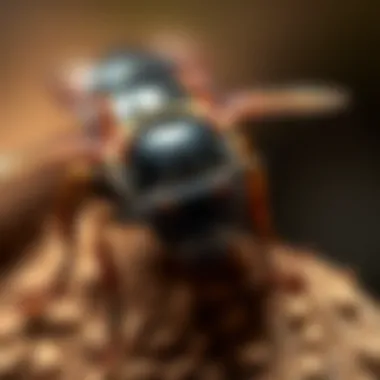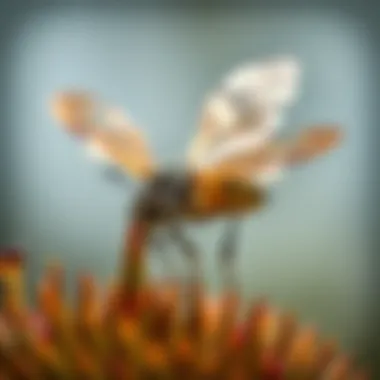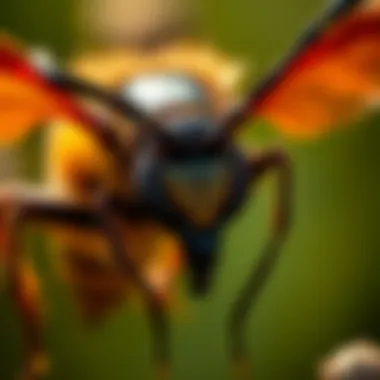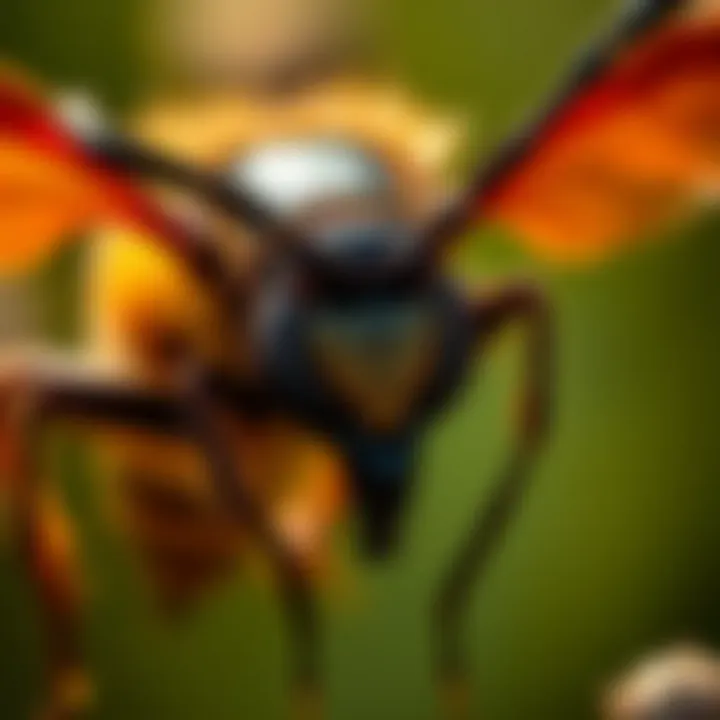Exploring Essential Oils as Natural Insecticides


Intro
The increasing awareness about the impact of synthetic pesticides on health and the environment has shifted the focus toward more sustainable pest management strategies. One promising alternative is the use of essential oils, which are derived from plants and possess potent insecticidal properties. These oils not only target various pests effectively but also offer a more eco-friendly solution for homeowners and garden enthusiasts alike. By understanding how these natural remedies work against pests, individuals can make informed choices about pest control methods that align with their ecological values.
This comprehensive examination dives into the myriad ways essential oils can serve as insecticides. The article details the mechanisms underlying their efficacy, assesses specific oils suitable for pest management, and examines their application methods. Moreover, it discusses the ecological considerations linked to employing essential oils in pest control, aiming to foster sustainable practices that mitigate environmental harm while effectively managing pest problems.
Understanding Essential Oils
The role of essential oils in pest management can’t be underestimated. Households often deal with pesky insects that, if not controlled, can cause irritation and damage. This section offers a solid grounding on essential oils, elucidating their significance as insecticides. Understanding this topic is pivotal for making informed choices about pest control, especially for housewives and homeowners aiming for safer, eco-friendly solutions.
Essential oils, derived from plants, bring with them a bouquet of benefits. Unlike synthetic insecticides, these oils are often perceived as natural, minimizing exposure to harsh chemicals in and around the home. Knowing how these oils work, their composition, and how they are extracted is paramount for individuals seeking sustainable pest solutions.
Definition and Composition
Essential oils are concentrated liquids that capture the characteristic fragrance and essence of the parent plant. These oils consist of a complex mixture of volatile compounds, predominantly terpenes and phenolic compounds, that are responsible for their unique properties.
These compounds can be realized in varied ways, depending on the plant species and the environmental conditions. For instance, lavender oil boasts linalool, lending it calming properties, while peppermint oil contains menthol, known for its invigorating scent.
Understanding this composition allows individuals to choose the right essential oils for specific insect problems, making it integral to the pest management dialogue.
Extraction Methods
The method of extraction plays a crucial role in determining the quality and effectiveness of essential oils. Several methods exist, each with its own pros and cons. In the realm of pest control, it’s essential to know these methods to select the best oils for effective insecticidal properties.
Steam Distillation
Steam distillation is often touted as the gold standard for extracting essential oils. The process involves passing steam through plant materials, allowing volatile compounds to vaporize. As the steam cools, it condenses back to liquid, where the oil can be separated. One of the key characteristics of steam distillation is its ability to maintain the oil’s integrity, capturing most of the aromatic compounds found in raw plants.
Its popularity in this article stems from its established effectiveness in producing high-quality oils. However, it does require specialized equipment and can be time-consuming, which may deter some home distillers.
Cold Pressing
Cold pressing stands out as a method primarily used for citrus fruits. The process involves mechanically pressing the peels to release the oils. This method is beneficial because it preserves the oil’s natural properties, avoiding heat exposure that might degrade some beneficial compounds. One key characteristic of cold-pressed oils is their vibrant, fresh scent, which can be quite alluring.
Yet, this method has its limitations, as it largely applies to specific citrus plants. Homeowners looking to utilize essential oils for pest control will find this method useful when considering citrus oils, particularly for their pest-repelling qualities against flies and ants.
Solvent Extraction
Solvent extraction is another avenue for obtaining essential oils, particularly for delicate flowers that can’t tolerate heat. It involves using a solvent to dissolve plant material, after which the solvent is removed to leave behind the aromatic essence. This method unlocks a wide range of oils, making it beneficial for extracting scents that might not be viable through other methods.
However, a significant concern with solvent extraction is potential chemical residue, which could undermine the natural aspect of the oils. Homeowners mindful of purity may need to weigh this method carefully when choosing oils for their insecticidal properties.
Overall, these extraction methods greatly influence the efficacy and appeal of essential oils as insecticides, thus warranting close consideration for anyone looking to integrate them into pest control practices.
The Science of Insecticides
Understanding the science behind insecticides is crucial for anyone interested in pest management, especially when it comes to using essential oils. They offer a natural alternative to traditional chemical pesticides and have gained attention for their efficacy and safety. Knowing how these insecticides relate to the pests they target can help shape more effective strategies in managing various infestations around the home and garden.
A deeper insight into the mechanisms of action and biological targets helps us appreciate how these products can be both effective and eco-friendly. With growing concerns about environmental impacts and human health, essential oils present a valuable addition to pest control methods.
Mechanisms of Action
Contact Poison
Contact poisons are a foundational aspect of many essential oil insecticides. These substances function by directly affecting insects when they make contact with the treated surface or application. The key characteristic of contact poisons is their immediate impact, which is especially beneficial when targeting insects that move across surfaces where the oils are applied.
The unique feature of contact poisons is their ability to disrupt the normal functioning of an insect's physiology quickly. For instance, oils like clove and rosemary have been noted for their potency in shutting down arthropod activity almost instantaneously, making them preferred choices for immediate pest management. While there are advantages, one must also consider that these poisons may not persist for long durations, which could require repeated applications.
Digestive Insecticide
Digestive insecticides operate by being ingested by pests. Once consumed, these oils interfere with the digestive system, making them unable to process food effectively. A prime example is peppermint oil, which has shown success in this category.
The key characteristic of digestive insecticides is their delayed action, which can sometimes be a double-edged sword. On one hand, it gives insects time to move away, leading to a dispersal that might reduce their number. However, it can also mean longer wait times for the homeowner, as the outcomes are not immediate. Understanding this aspect allows for strategic application timing, such as applying these oils when pest activity is high.
Fumigant
Fumigants serve a unique role in pest control. They function by creating vapor that is inhaled by pests, leading to toxicity. Essential oils like eucalyptus and thyme are often employed in fumigants.
The key advantage of these essential oil fumigants is their ability to reach insects hiding in cracks and crevices, as they disperse throughout an area. However, caution must be exercised; essential oil fumigants can sometimes be potent, requiring measures to ensure they do not impact non-target organisms, such as pets or beneficial insects. Understanding the balance between efficacy and safety is essential when utilizing this method.
Biological Targets


Nervous System Interference
Essential oils can significantly disrupt the nervous systems of insects, leading to paralysis or death. This method is often potent as it directly impacts an insect's ability to respond to its environment. Oils like lavender have shown notable efficacy in this area.
The key advantage in targeting the nervous system is the relatively quick knocking out of pests' mobility. However, the challenge lies in ensuring that such treatments do not adversely affect beneficial insects, as some essential oils can affect non-target species as well.
Metabolic Disruption
Metabolic disruption through essential oils hampers an insect's ability to process energy and nutrients, leading to declines in pest populations. Oils such as cinnamon have demonstrated this kind of action effectively.
The distinctive feature of metabolic disruption is that it attacks pests in a way that makes them unable to survive on their preferred food sources, which can lead to a gradual decline in their numbers over time. The downside, however, is that pests may develop resistance to such treatments if used over extended periods without proper rotation.
Reproductive Effects
Finally, essential oils can also impact the reproductive systems of certain pests, limiting their population growth. Oils such as citronella and neem have been recognized for this effect.
A critical aspect to acknowledge is the long-term efficacy of targeting reproduction. If the reproductive capability of a pest is curtailed, it leads to significant reductions in population over time. However, these effects might take time to manifest, requiring patience from those using these oils for pest control.
In short, understanding the science that drives insecticide functionality can empower homeowners to tackle pest challenges with more confidence and knowledge.
Efficacy of Essential Oils as Insecticides
The efficacy of essential oils as insecticides cannot be overstated. In recent years, the increasing concern over synthetic pesticides and their negative impact on health and the environment has led many to explore natural alternatives. Essential oils, derived from various plants, offer a promising solution. They can be potent against a range of pests while generally posing a lower risk to human health and non-target organisms. Understanding their effectiveness hinges on several factors, including the specific pests they target, application methods, and potential advantages over conventional insecticides.
Commonly Used Essential Oils
Lavender
Lavender is a well-known essential oil that stands out for its soothing scent and insecticidal properties. Known scientifically as Lavandula angustifolia, its key characteristic is the presence of linalool and linalyl acetate, compounds that have been shown to disrupt the nervous systems of insects. This makes lavender a beneficial choice in pest management. The distinctive aroma not only repels moths and mosquitoes but also makes it pleasant for humans. One advantage of lavender is its dual function as a pest repellent and a fragrant addition to home products, while a potential downside might be its reduced effectiveness in high humidity conditions.
Peppermint
Peppermint, or Mentha piperita, is noted for its strong menthol scent which acts as a powerful deterrent to various insects. It’s particularly effective against ants, spiders, and mosquitoes, making it an appealing option for households looking to keep these pests at bay. One of the key benefits of peppermint essential oil is its quick action; insects often exhibit immediate avoidance behavior upon exposure. However, its strong scent may not be suitable for everyone, and it can sometimes interfere with the aroma of other household products.
Eucalyptus
Eucalyptus essential oil, known for its refreshing and invigorating scent, serves as another formidable insecticide. The oil, extracted from the Eucalyptus globulus tree, contains eucalyptol, which has been linked to insect repellent activity. Eucalyptus is particularly effective against flies and mosquitoes, making it ideal for outdoor settings. Its key advantage is the long-lasting protective barrier it can create when used in sprays. A downside, however, is that some may find its scent overwhelming in enclosed spaces.
Tea Tree
The essential oil derived from Melaleuca alternifolia, commonly known as tea tree oil, is a multifaceted option in pest control. Renowned for its antimicrobial properties, tea tree oil also exhibits significant insecticidal effects against a variety of pests. Its ability to combat not only infestations but also mold and mildew makes it a star in home settings. The unique feature of tea tree oil is its therapeutic grade, ensuring safety in personal care products. One consideration, however, is that its scent isn't universally appreciated, and overuse can lead to skin sensitization issues in some individuals.
Comparative Studies
Effectiveness Against Specific Pests
Assessing the effectiveness of essential oils against specific pests is crucial for anyone considering this approach. Research has indicated that oils like peppermint and lavender tend to perform better against common household insects, including mosquitoes and flies. Such effectiveness can often be quantified through comparative studies that measure pest mortality rates when exposed to differing concentrations of these oils. This aspect of efficacy not only informs users about which oils to use but helps tailor strategies for pest management in various settings, making essential oils a tactical ally in pest control.
Synergistic Effects with Other Compounds
Another fascinating aspect of essential oils as insecticides lies in their potential for synergistic effects when combined with other compounds. Some studies have shown that blending essential oils with certain plant extracts enhances their insecticidal potency. This means that using a combination of lavender and peppermint, for example, could produce a more powerful deterrent than using either oil alone. Understanding these complex interactions can lead to more effective formulations, thereby increasing reliance on natural insecticides while minimizing dependency on synthetic chemicals. However, caution should be exercised, as not all combinations may yield favorable results, and testing is often necessary.
"Combining different essential oils might not only amplify their insecticidal strength but also create a more pleasant aroma for human users."
Formulation of Essential Oil Insecticides
Understanding how to effectively formulate essential oil insecticides is crucial for both efficacy and safety. The formulation process encompasses the dilution and concentration of oils, alongside application methods. This attention to detail not only enhances the insecticidal properties of essential oils but also mitigates potential risks to human health and the environment. In this section, we will carefully explore how different components like carrier oils and emulsifiers aid in creating effective solutions while discussing diverse application methods that integrate essential oils into pest control strategies.
Dilution and Concentration
Carrier Oils
Carrier oils play an essential role in formulating essential oil insecticides. They dilute the potency of the concentrated essential oils, giving a balanced blend that is less likely to irritate the skin while maintaining effectiveness against pests. A popular choice is coconut oil due to its smooth texture and skin-friendly properties.
This oil not only absorbs well but also enhances the stability of the essential oils when mixed. However, one must be careful—a too high concentration of essential oils can lead to skin sensitivity or adverse reactions. While using carrier oils, it is key to respect recommended dilution ratios to ensure effectiveness without compromising safety.
Emulsifiers
Emulsifiers are compounds that help mix oil-based and water-based substances, which is vital for creating stable pesticide formulations. They allow essential oils to evenly disperse in water, increasing the effectiveness of the spray. A common emulsifier is polysorbate 20, which helps maintain consistency in formulations.
The ability of emulsifiers to hold together disparate elements makes them invaluable in production. However, it's worth noting that certain emulsifiers can alter the action of essential oils, either enhancing or diminishing their efficacy. Careful consideration is required when selecting emulsifiers that align with desired outcomes.


Application Methods
Sprays
Sprays are one of the most widely employed methods for applying essential oil insecticides. This method enables a quick and uniform application over plants or surfaces, making it suitable for both indoor and outdoor use. The ability to cover large areas efficiently is a significant advantage; however, one must ensure that the spray is directed properly to avoid harming beneficial organisms or non-target plants.
Spraying is advantageous due to its ability to provide more immediate contact with pests. The downside lies in the potential for rapid degradation of essential oils when exposed to sunlight or air, which may necessitate frequent reapplication.
Diffusion Systems
Diffusion systems introduce essential oils gradually into the target environment, which can be particularly effective for maintaining a pest-free area over an extended period. These systems release a continual stream of essential oils into a designated space, creating an inhospitable environment for pests.
While this method offers sustained exposure, it might not be immediately effective against a heavy pest infestation. Another limitation is the requirement for specific devices, which might not be readily accessible for all homeowners.
Soil Drenching
Soil drenching involves applying diluted essential oils directly to the soil, allowing the plants to absorb the natural pesticides through their root systems. This method penetrates the soil, targeting pests effectively while minimizing direct exposure to beneficial insects. It’s particularly advantageous for protecting roots and preventing soil-borne pests.
However, soil drenching demands precise application rates and thorough knowledge of the soil conditions, as an improper ratio can lead to waste or damage. Monitoring the soil’s moisture content is essential to ensure the effectiveness of this method.
Maintaining a balance in the formulation process is key to harnessing the power of essential oils effectively against pests. Each method has its own merits and challenges, making it imperative for homeowners to choose wisely based on their specific needs.
In the upcoming sections, we’ll explore safety and toxicity considerations when using essential oil insecticides, ensuring a well-rounded understanding of all facets in pest control strategies.
Safety and Toxicity Considerations
When considering any form of pest control, understanding the implications of safety and toxicity is non-negotiable. Essential oils are often touted for their natural derivation, giving them an image of safety in comparison to synthetic chemicals. However, just like other natural substances, they aren’t without risks. The focus on safety and toxicity not only shields users and non-target organisms from potential harm but also enhances the credibility of essential oils as viable insecticides. By analyzing these facets, we ensure that the benefits of utilizing essential oils outweigh the risks involved.
Human Safety
Skin Sensitization
Skin sensitization refers to an immune response that occurs after exposure to a substance. Essential oils like lavender and tea tree can sometimes provoke skin reactions in sensitive individuals. It’s essential to know that while these oils offer various benefits, they can also cause allergic reactions in some people. Understanding this risk highlights the importance of patch testing oils before widespread use. In this article, we emphasize the relevance of skin sensitization to ensure users are informed and take necessary precautions while enjoying the benefits of essential oils. The advantage for users is heightened awareness, ensuring safer application methods.
Inhalation Risks
Inhalation risks pertain to the potential adverse effects that may occur when essential oils are vaporized or aerosolized. Some essential oils can cause respiratory discomfort or irritation. For instance, oils with strong constituents like peppermint or eucalyptus can help repel insects but may also aggravate asthma conditions. Educating users on inhalation risks is crucial in our discussion. Moreover, while necessary for efficacy, the correct usage and dosage are vital to avoid any negative side effects. Our examination of inhalation risks ensures that essential oil application remains a safe method for pest control, safeguarding respiratory health while combating pests effectively.
Environmental Impact
Non-target Effects
Non-target effects refer to the unintentional impact that insecticides may have on organisms other than the intended pests. One hallmark of using essential oils is the often-reported selectivity towards pests over beneficial species. However, this may vary based on concentration and application methods. The proactive evaluation of non-target effects in this article serves to underscore responsible usage and formulation of essential oils in pest control. An awareness of these effects means users can make informed decisions, minimizing harm to beneficial insects and maintaining ecological balance in their gardens.
Pollinator Safety
Pollinator safety is a significant aspect of environmental impact. With bees and other pollinators facing numerous threats, the careful application of essential oils is paramount. Several essential oils, notably mint or citrus types, can be harmful to these vital creatures if not applied correctly. In this article, we highlight the characteristics that make certain oils safer for pollinators, aiming to preserve their populations while still effectively managing pest issues. Emphasizing pollinator safety demonstrates a commitment to sustainable practices in pest management, further proving the versatility and responsibility that essential oils can offer in pest control.
Regulatory Framework
The regulatory framework surrounding essential oils as insecticides plays a pivotal role in ensuring their safe application and effectiveness while meeting legal standards. This segment delves into how regulations govern the use of essential oils for pest control, emphasizing the significance of approval processes and emerging trends in sustainability. This is especially pertinent for environmentally conscious homeowners and gardeners looking to implement responsible pest management strategies.
Approval Processes
EPA Regulations
EPA regulations set forth guidelines that products must meet before being marketed as insecticides. The agency evaluates essential oils for efficacy, safety, and environmental impact. A key characteristic of these regulations is the necessity for thorough testing and documentation, something that helps both manufacturers and consumers. By adhering to these stringent requirements, essential oil insecticides are seen as reputable and trustworthy options within the pest control sector.
It’s worth noting that a unique feature of EPA regulations is their adaptability; they can evolve in response to new scientific findings. This can be advantageous, as it allows the field to stay current with emerging knowledge about potential risks. However, this adaptability can also mean added layers of complexity for producers, who must stay abreast of changing guidelines.
Labeling Requirements
Labeling requirements are another critical aspect of the approval process. The labels on essential oil insecticides must include specific information about ingredients, application instructions, and safety warnings. This characteristic is vital as it empowers consumers with knowledge, thus ensuring they can use these products safely and effectively. Accurate labeling contributes significantly to the goal of safe pest management by outlining the proper usage of essential oils while mitigating risks to non-target organisms.
Moreover, a unique feature of labeling requirements is the emphasis on clarity and ease of understanding. This focus can be beneficial for consumers, as simple, clear instructions help to minimize misuse of the product, leading to better pest control outcomes. On the flip side, if labeling is too technical or unclear, it may deter users from adopting these ecologically friendly pest management solutions.
Emerging Trends
Organic Certification
Organic certification refers to the processes that allow essential oil products to be recognized as organic under specific guidelines. This is significant for those interested in maintaining a natural environment, resonating well with consumers who prioritize health and sustainability. Importantly, certified organic products often garner higher trust from consumers, leading to an increase in their popularity within the pest control market.


One of the unique aspects of organic certification is its adherence to rigorous standards throughout the production chain, from farming practices to processing and labeling. This extensive vetting provides consumers peace of mind regarding the integrity of the product. However, achieving and maintaining organic certification can be a daunting task for producers, often requiring substantial time and financial investment.
Sustainability Metrics
Sustainability metrics evaluate the environmental impact of essential oils used in pest management. These metrics include factors like resource use, ecological footprint, and long-term viability. Their significance lies in promoting pest control methods that are not only effective but also environmentally sound. As homeowners become more eco-conscious, sustainable practices in pest management are gaining traction, making this trend particularly relevant.
A distinct feature of sustainability metrics is their ability to provide quantifiable data, enabling producers to assess and communicate the ecological benefits of their products. This can be incredibly advantageous, highlighting eco-friendly choices for consumers seeking to make informed decisions. However, relying solely on metrics without considering location-specific ecological factors may lead to generalized conclusions that overlook the complexities of local ecosystems.
Integrating essential oil insecticides into modern pest control practices demands a thorough understanding of the regulatory framework, ensuring efficacy and safety for users and the environment.
Integrating Essential Oils into Pest Control Strategies
The incorporation of essential oils within pest control strategies represents a pivotal shift in how we tackle insects. More than just a fleeting trend, this practice offers a multi-faceted approach to manage pests sustainably while maintaining environmental integrity. Essential oils serve not only as insecticides but also as part of a broader ecosystem management strategy. By blending various methods, homeowners and gardeners can create robust pest management solutions that enhance plant health and resilience.
Complementary Practices
Cultural Control
Cultural control refers to modifying farming practices and environments to make them less favorable for pest infestations. It’s like putting out a welcome mat for the well-behaved critters while telling the pests to shove off. This can include crop rotation, planting pest-resistant varieties, and adjusting planting times.
The key characteristic of cultural control is its emphasis on preventing pest problems before they arise. This preemptive strategy is advantageous as it minimizes the reliance on chemical treatments, which can have negative impacts on non-target species. Unique features of cultural control strategies include their adaptability and low cost, making them an attractive and popular option for many. While the effectiveness can vary depending on the specific pests and environmental conditions, the benefits often outweigh the disadvantages.
Biological Control
On the other hand, biological control involves using natural predators or parasites to control pest populations. Think of it like calling in the friendly neighborhood spiders to help out against the aphid invasion. This method encourages a balanced ecosystem by allowing beneficial organisms to thrive, directly impacting harmful pest numbers.
Biological control offers a key advantage by reducing chemical inputs in pest management. The unique feature of this approach lies in its sustainability; it utilizes the natural relationships in ecosystems instead of relying on external inputs. However, biological control is not foolproof. Sometimes, it can take time for populations of beneficial organisms to establish, and they may not control all pests effectively.
Case Studies
Home Gardening
Home gardening provides a practical context to explore pest control strategies involving essential oils. When done right, using essential oils can help keep pests at bay without harming the plants or the environment. For instance, a gardener might use lavender oil as an effective repellent against mosquitoes and other midges. This not only protects the garden but also creates a pleasant aroma for the gardener.
The key characteristic of home gardening is its accessibility and control over the environment. This makes it a favorable choice as homeowners can experiment with various oils and methods to determine what works best for their specific conditions. However, placing all bets on essential oils might not yield the desired results in every situation.
Agricultural Applications
In agriculture, the stakes are higher. Farmers often face infestations that threaten their crops and livelihoods. The use of essential oils in large-scale farming can complement other pest control strategies, presenting a viable alternative to synthetic chemicals. For example, eucalyptus oil has been shown to be effective against whiteflies.
What sets agricultural applications apart is the scale at which these methods are implemented. It provides an opportunity for wider adoption of sustainable practices within the industry. However, farmers may face challenges, such as the variability of essential oil efficacy against different pests and the need for extensive testing before commercial adoption.
"The beauty of integrating essential oils into pest control strategies lies in their potential to create a harmonious balance within ecosystems, steering clear of harmful chemicals while promoting biodiversity."
Understanding these complementary practices within pest control allows for more informed decisions, leading to more sustainable and effective management strategies.
Future Directions in Research
The exploration of essential oils as insecticides is a field ripe with potential. As we look to the future, several emerging trends suggest avenues for enhancing their effectiveness and practicality. Understanding these trends is crucial for further establishing essential oils in pest control strategies. Both innovative formulations and potential expansions are vital in propelling the application of essential oils into mainstream pest management practices.
Innovative Formulations
Nanoemulsions
One particularly intriguing development in this space is nanoemulsions. These are tiny droplets of oil in water, profoundly increasing the surface area available for action. The key characteristic of nanoemulsions is their ability to improve the solubility and stability of essential oils, enhancing their efficacy against pests. This characteristic makes them a beneficial choice, providing improved delivery and penetration into pest tissues.
The unique feature of nanoemulsions is that they can often bypass the usual barriers that some pests may have developed against more traditional formulations. This increases their effectiveness while potentially reducing the amount needed for effective pest management. One downside to consider is that the process to create nanoemulsions can require more sophisticated technology, raising costs initially. However, the long-term benefits in terms of efficacy might outweigh these initial investments.
Slow-release Products
Another innovative formulation is slow-release products. These formulations are designed to release their active ingredients gradually over time. This key characteristic of slow-release products allows for prolonged effectiveness and reduced frequency of application, making them a popular choice for both home gardeners and agricultural use alike. By extending the control period, these products can contribute to a more consistent pest management strategy.
The uniqueness of slow-release formulations lies in their capacity to minimize the risk of pest resistance developing. Since pests are less likely to encounter the active ingredient in high concentrations, they have fewer opportunities to adapt. The downside, however, can be the initial cost, which may deter some smaller-scale users. Nevertheless, for those seeking sustainable pest management solutions, the potential long-term savings could be substantial.
Potential Expansions
Research in New Oils
The significance of research in new oils cannot be overstated. As scientists identify and evaluate more essential oils, the range of available options for pest control continues to grow. This exploration brings to light diverse properties and efficacy against various pests. The key characteristic that often arises from this research is the discovery of essential oils that not only work well alone but also have synergistic effects when combined with existing oils. This makes them a beneficial addition in the pest management toolbox.
New oils may also exhibit lower toxicity to non-target species, increasing their attractiveness for environmentally conscious users. However, on the flip side, comprehensive research and validation processes can be time-consuming, which may slow the availability of promising new products on the market.
Broader Applications in Pest Management
Finally, the broader applications in pest management of essential oils present an exciting area for advancement. Exploring ways to integrate essential oils into more traditional pest management frameworks is a key aspect of this trend. This could mean applying essential oils not just as standalone products but also as part of integrated pest management (IPM) systems, saliently contributing to the overall strategy against pest invasions.
The significant advantage here lies in the amalgamation of traditional methods with modern, eco-friendly solutions. This blended approach serves to not just manage individual pests but can also promote overall ecosystem health. One challenge may be the initial resistance from practitioners who are used to established products and methods, potentially hampering rapid adoption. However, as more success stories surface demonstrating the efficacy of this integration, acceptance may rise.
"The future is not something we enter. The future is something we create."
This outlook rings particularly true for the research of essential oils as insecticides. By embracing new ideas and methodologies, the field can advance in exciting ways.



